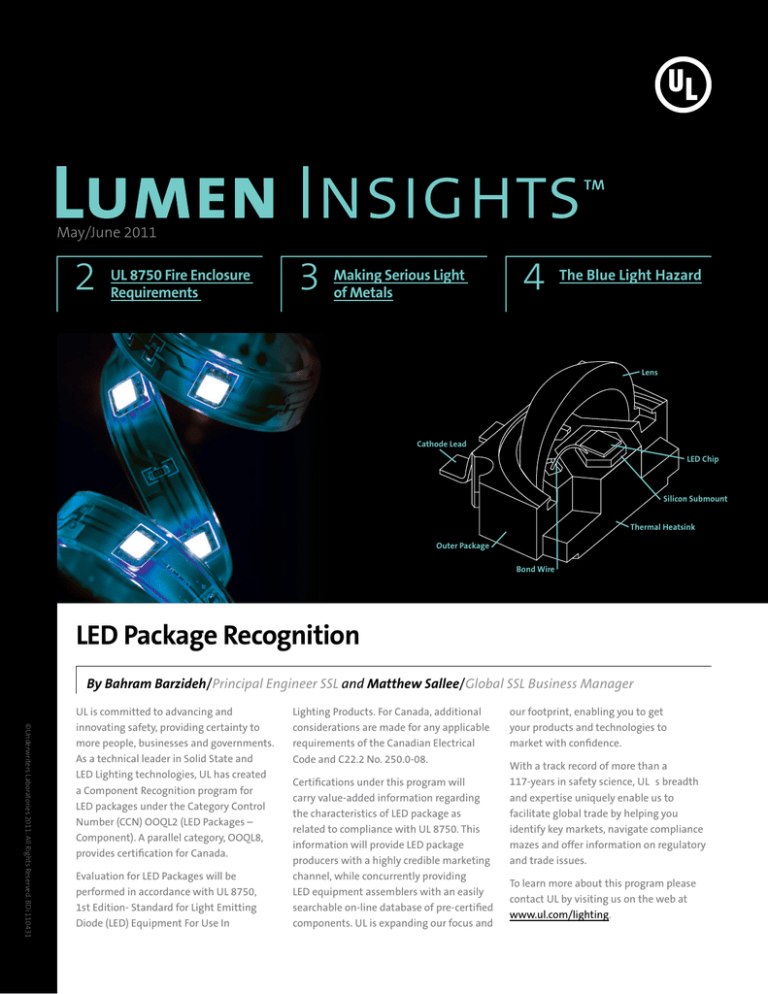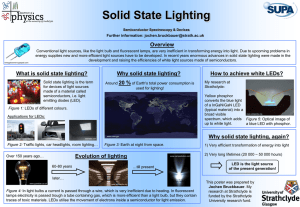
May/June 2011
2
UL 8750 Fire Enclosure
Requirements
3
Making Serious Light
of Metals
4
The Blue Light Hazard
Lens
Cathode Lead
LED Chip
Silicon Submount
Thermal Heatsink
Outer Package
Bond Wire
LED Package Recognition
By Bahram Barzideh/Principal Engineer SSL and Matthew Sallee/Global SSL Business Manager
©Underwriters Laboratories 2011. All Rights Reserved. BDi 110431
UL is committed to advancing and
innovating safety, providing certainty to
more people, businesses and governments.
As a technical leader in Solid State and
LED Lighting technologies, UL has created
a Component Recognition program for
LED packages under the Category Control
Number (CCN) OOQL2 (LED Packages –
Component). A parallel category, OOQL8,
provides certification for Canada.
Evaluation for LED Packages will be
performed in accordance with UL 8750,
1st Edition- Standard for Light Emitting
Diode (LED) Equipment For Use In
Lighting Products. For Canada, additional
considerations are made for any applicable
requirements of the Canadian Electrical
Code and C22.2 No. 250.0-08.
Certifications under this program will
carry value-added information regarding
the characteristics of LED package as
related to compliance with UL 8750. This
information will provide LED package
producers with a highly credible marketing
channel, while concurrently providing
LED equipment assemblers with an easily
searchable on-line database of pre-certified
components. UL is expanding our focus and
our footprint, enabling you to get
your products and technologies to
market with confidence.
With a track record of more than a
117-years in safety science, ULʼs breadth
and expertise uniquely enable us to
facilitate global trade by helping you
identify key markets, navigate compliance
mazes and offer information on regulatory
and trade issues.
To learn more about this program please
contact UL by visiting us on the web at
www.ul.com/lighting.
[ May/June 2011 ]
A Letter from Alberto
From new
recognition
programs for
LED Packages, to
award-wining
photometric
testing
equipment,
UL continues to
innovate and expand what safety
means for the rapidly changing
lighting marketplace. Only UL has
built a foundation of expertise
that places us at the center of
complex global safety dialogues.
Today in lighting, safety discussions
are around more than risk of
fire and shock. How can UL help
foster new technology into the
global marketplace, protecting
people, products and places?
In this issue of Lumen Insights
we focus on the LED Package:
New Recognition Programs,
New UL8750 requirements,
New research on sustainability
and photobiological hazards.
We look forward to seeing you
at Lightfair, join our presentation
on Photobiological safety during
the show, and would welcome
you to visit our booth 561.
Kind Regards,
Alberto Uggetti
VP and GM Global Lighting
UL 8750 Fire Enclosure
Requirements
By Michael Shulman/Principal Engineer Lighting
A primary expectation for any product listed in accordance with a UL standard
is that it will ‘do no harm.’ One example is if a fire were to start within the
product — the product is expected to manage the situation in a manner that
will not allow the incident to spread to the building or other products in the
vicinity. To accomplish this, most UL standards have vigorous and demanding
requirements for the product enclosure.
Polymer (plastic) materials used for an enclosure are typically required to
comply with certain flammability ratings (such as 5V or V0, whose test
methods are described in the UL 94 standard) that reflect the material’s ability
to self-extinguish when faced with a fire incident. This ability is often related
to the amount and type of flame retardant content in the formulation of the
specific polymer.
Legacy luminaire technologies (incandescent, fluorescent, HID) use light
sources made of metal and glass. Because these materials are non-flammable,
the safety standards do not require them to be within a fire enclosure. LED
technology, however, includes many small pieces of organic (potentially
flammable) material in or near the light source, most notably the LED optics
and the coating or insulating materials on the printed circuit board (on which
the LEDs are mounted). So it is reasonable for the safety standard for LED
equipment, UL 8750, to require this “fuel” to be adequately enclosed.
But there’s a conflict here — a higher levels of flame retardant can adversely
impact optical clarity. LED equipment producers do not want to sacrifice optical
performance, and they cannot sacrifice product safety.
UL will be presenting a potential solution at the UL 8750 Standard Technical
Panel (STP) meeting this summer. Using hazard based safety engineering
(HBSE) principles, UL will propose an alternative approach — rather than
relying exclusively on an enclosure to contain a fire, certain exemptions to
the fire enclosure requirements by instead reducing the risk of fire ignition by
measurable limits on the available electrical or thermal energy can be applied
to reduce the risk of fire ignition. If there is no ignition, there is no fire than
needs to be contained. UL believes that this alternative fire management
strategy will avoid the need to make any compromises between LED product
safety and performance.
[2]
UL.com/lighting
Making Serious Light of Metals
By Roger Franz/UL Environmental Scientist
The tungsten lamp that has been the
mainstay of so many lighting applications
for a hundred years is being phased out in
favor of more energy efficient technologies.
Two of the emerging candidates are
compact fluorescent (CFL) and solid
state lighting (SSL), the latter being
based on light emitting diodes (LEDs).
In this article we contrast the materials
supply aspects of tungsten vs. LEDs.
Tungsten is a metal that is widely available
from deposits in the US and Canada,
although China is by far the dominant
supplier and user. Tungsten has been
named one of the Conflict Minerals due
to trade practices and human rights the
turmoil in the Republic of the Congo,
along with tantalum, tin, and gold. While
these social concerns have attracted
attention, the US Geological Survey
data1 does not list any recent commerce
based on the Congo’s tungsten supply.
While providing significantly greater
efficacy in terms of lumens per watt,
LEDs are based on materials that are
much more limited. A common type of
semiconductor used to make LEDs is
based on the periodic table group III and
V elements, indium (In), gallium (Ga) and
nitrogen (N), combined to make InGaN.
Neither indium or gallium exists in
economically viable concentrations that
can be used to produce them directly;
rather, they are trace byproducts of mining
and refining other primary metals like
aluminum, zinc, copper or tin. And once
they are fabricated into working diodes,
there is no viable process today for recycling
them back into further use. (On a positive
note, nitrogen is very abundant, since it
is some 78% of earth’s atmosphere and
as an element is not in short supply.)
1 “Tungsten.” 2008 Minerals Yearbook, U.S. Department of the Interior, U.S. Geological Survey.
2 “Energy critical Elements: Securing Materials for Emerging Technologies.” American Physical Society
(APS) Panel on Public Affairs and the Materials Research Society (MRS), Feb., 2011.
[3]
Along with several other elements, indium
and gallium have also been identified by
materials scientists and physicists as Energy
Critical Elements2. Both indium and gallium
may also be used in photovoltaic cells to
capture solar energy, compounding the
potential concern over their availability.
As a result, there is a need for research
on alternative materials, ways to use less
without sacrificing performance, and
addressing the geopolitical aspects of
supply assurance. By taking these actions,
we can continue to move to the next level
of renewable energy and lighting efficacy.
We’d openly welcome industry
representatives to join the discussion
through our Standards Technical Panel,
while we write ULE106, Sustainability
of Luminaires at http://csds.ul.com.
[ May/June 2011 ]
The Blue Light Hazard
By Winn Henderson/Subject Matter Expert, LED Optical Radiation
UL can presently evaluate lighting products
to both IEC 62471 and ANSI/IESNA RP 27
— the Photobiological Safety requirements
for lamps and lamp systems. UL currently
has an IEC 62471 Certification Body
Testing Laboratory (CBTL) in Research
Triangle Park, NC, USA, and can issue CB
Test Reports and Certificates to IEC 62471.
UL is also able to perform Photobiological
Safety testing in Europe and in Asia.
4.50E-06
4.00E-06
3.50E-06
3.00E-06
2.50E-06
2.00E-06
1.50E-06
1.00E-06
5.00E-07
0.00E+00
380
392
404
416
428
440
452
464
476
488
500
512
524
535
548
560
572
584
596
606
620
632
644
656
668
680
692
704
716
728
740
752
764
776
788
800
The intent of Photobiological safety
requirements are to protect the
eye and skin from harmful optical
radiation. Photobiological requirements
are mandatory for many safety
certification programs for Europe.
made to the Standards Technical Panel
(STP). During the July STP meeting, this
proposal will be discussed. This proposal
would make photobiological testing
mandatory for LEDs in North America.
Irradiance (W/cm*2)
For visible lamp radiation, including
the radiation emitted from LEDs, there
is a specific concern about the hazards
associated from the blue light wavelengths
of the radiation. Blue light hazards are
principally in the 400–500nm range with a
peak of approximately 440nm. One of the
main concerns is photochemical damage
to the retina of the eye. Photochemical
change occurs when light causes
chemical reactions in the body’s tissue
— in this case eye tissue. The damage
to the retina could result in blind spots.
The blue light hazard from lamp and
LED radiation is specifically addressed
in ANSI/IESNA RP 27 and IEC 62471.
A proposal to incorporate photobiological
safety requirements into UL 8750 has been
Wavelength (nm)
Come See Us
May 18, 2011 — 4:30PM
Lightfair 2011 / Photobiological Safety
Standards for LEDs – Are You Ready?
UL Booth — 561
Training and Education Events
T: +1.888.503.5536
E: ULUniversity@us.ul.com
W: uluniversity.us
Designing for Compliance to UL 1598:
Electric Luminaires
June 7 – Northbrook, Ill.
August 2 – Hartford, Conn.
October 4 – Research Triangle Park, N.C.
LED Luminaires — Designing for
Compliance to UL 8750 (In Accordance
with UL 1598)
June 8 – Northbrook, Ill.
August 3 – Hartford, Conn.
October 5 – Research Triangle Park, N.C.
Share Your Insights: Lumen.Insights@us.ul.com.
Sign up at: www.ul.com/lumeninsights
UL Lumen Insights
Managing Editor: Matthew Sallee|matthew.sallee@us.ul.com
[4]
UL Lumen Insights
@lumeninsights



